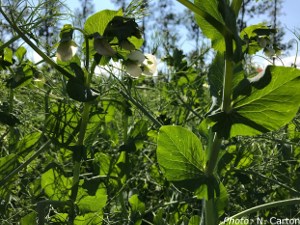Project responsible: Georg Carlsson, Department of Biosystems and Technology, SLU Alnarp.
Project group: Hanna Friberg, Department of Forest Mycology and Plant Pathology, SLU Uppsala; Georg Carlsson, SLU, Department of Biosystems and Technology, SLU Alnarp.
There is variability in the level of resistance to root rots among varieties of several legume species, however many species and varieties used in innovative cropping systems have not been characterized. Diversification by intercropping with non-host species has been shown to reduce root pathogen occurrence in some crop species but references are very scarce for grain legumes.
Moreover, it is not known if the combination of both strategies, i.e. using resistant legume varieties in mixtures with non-host species will lead to more efficient disease prevention than each strategy applied separately. Additional practical experience is required in order to give Northern European farmers clear recommendations.
This project will therefore investigate root diseases caused by Aphanomyces euteiches, Fusarium and Phytophtora pisi on different varieties of
grown as sole crops and intercropped with non-host species. Measurements of pathogen occurrence and disease severity will be performed in one greenhouse screening and in two field experiments.
- One field experiment compares two organic crop rotations differing in the frequency of legume species and the presence of crop mixtures.
- The second field experiment focuses on a three-year sequence with a high frequency of legumes in order to assess the capacity of resistant varieties and species mixtures to prevent the build-up of inoculum and the disease symptoms.
The project is expected to generate results for direct implementation in design of organic cropping systems where legumes are included both as cash and cover crops, and thereby contribute with a large part of the nitrogen supply.
